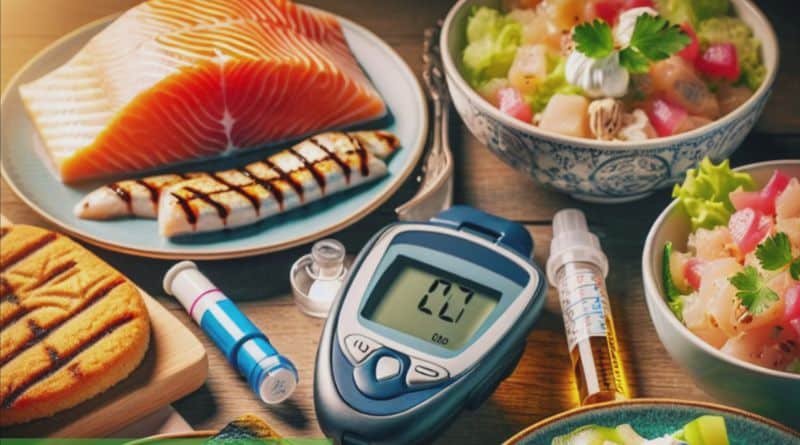Which Fish is Good for Diabetes? Expert Opinions and Health Insights
Have you ever wondered which fish is good for diabetes management? Well, you’re in the right place. Managing diabetes can feel like navigating a maze with endless twists and turns. One minute, you’re told to avoid carbs; the next, you’re encouraged to eat fiber, and then there’s the constant monitoring of blood sugar levels. Balancing medication, diet, and exercise can be overwhelming. But what about protein sources, specifically fish?
We’ll explore the best fish choices for diabetics, their health benefits, and how to incorporate them seamlessly into the diet. Popular options include salmon, known for its high omega-3 fatty acid content, which aids in reducing inflammation and enhancing heart health.
We’ll offer practical tips on selecting, preparing, and cooking these fish to ensure you enjoy the maximum benefit from every meal.
Whether you’re new to managing diabetes or looking to refine your dietary approach, this guide will provide you with valuable insights into making informed choices and maintaining a balanced, healthy diet.
Which Fish is Good for Diabetes? A Comprehensive Health Analysis
1. Salmon: Salmon is often at the top of the list when considering which fish is good for diabetes. Rich in omega-3 fatty acids, including EPA and DHA, this fatty fish is excellent for heart health and maintaining healthy cholesterol levels. Omega-3s are especially helpful in lowering inflammation across the body, a vital benefit for individuals with diabetes who face an increased risk of cardiovascular disease.
2. Mackerel: Mackerel is another oily fish loaded with omega-3s. In addition to its omega-3 content, it’s also high in coenzyme Q10, an antioxidant that helps energize cells and boost overall health. Coenzyme Q10 has been shown to improve blood sugar regulation making mackerel an intelligent choice for those managing diabetes.
3. Sardines: Tiny but mighty, sardines are a nutritional powerhouse. They are packed with omega-3s, Vitamin D, and calcium, making them an excellent choice for strengthening bones and overall health. Sardines are rich in Vitamin B12, which is essential for maintaining healthy nerve function and red blood cell formation.
4. Tuna: Tuna is a convenient and versatile fish that’s rich in protein and omega-3s. It’s best consumed in moderation due to its mercury content, which can accumulate in the body over time. The high protein content in tuna helps maintain muscle mass and provides long-lasting energy, making it a good option for a balanced diet.
5. Rainbow Trout: Rainbow trout is a beautiful source of lean protein and omega-3s. It’s also low in mercury, making it safer for frequent consumption. Rich in B vitamins, the fish supports energy metabolism and brain function, making it ideal for maintaining a healthy lifestyle.
6. Cod: Cod is a lean white fish that’s low in fat but high in protein. Its mild flavor makes it a versatile ingredient in many dishes, perfect for those watching their carb intake. Cod is a good source of iodine, which is essential for thyroid function and overall metabolic health.
7. Herring: Herring is another oily fish full of omega-3s and Vitamin D. It’s prevalent in Scandinavian countries and can be enjoyed pickled, smoked, or fresh.
Herring is rich in selenium, an essential mineral with antioxidant properties that help protect cells from damage and support a healthy immune system.
Why Fish is a Superfood for Diabetics
Fish has many nutritional benefits, including omega-3 fatty acids, vitamin D and B2 (riboflavin), calcium, phosphorus, and minerals such as iron, zinc, iodine, magnesium, and potassium.
These nutrients are beneficial for everyone, but particularly so for individuals managing diabetes. Regular consumption of fish can contribute to a balanced diet, support overall health, and help control blood sugar levels.
Omega-3 Fatty Acids: Fish is highly recommended for diabetics because of its high content of omega-3 fatty acids. These healthy fats have been shown to reduce inflammation, lower blood pressure, and reduce the risk of heart disease—an important consideration for diabetics who are at higher risk of cardiovascular issues.
Omega-3 fatty acids are essential for brain health and cognitive function, aiding in the prevention of cognitive decline and supporting mental well-being. These nutrients contribute to joint health by alleviating arthritis symptoms and enhancing mobility for individuals with joint-related issues

The Benefits of Including Fish in Your Diet
Grilling and Baking: Grilling and baking are two of the healthiest ways to prepare fish. These methods require little to no added fat, preserving the fish’s natural flavors and nutrients. Grilling imparts a smoky flavor that enhances the taste, while baking can be done with a variety of herbs and spices to create a delicious, healthful meal.
Steaming: Steaming is another excellent cooking method that ensures all nutrients are retained. Using a steamer, you can cook fish quickly and evenly without losing any of its essential vitamins and minerals.
Plus, it’s quick and easy, perfect for busy weeknights. You can enhance the flavor with ingredients like lemon, ginger, or garlic.
Including Fish in Salads: Adding chunks of grilled or baked fish to salads is a fantastic way to boost the protein intake without loading up on carbs. It makes the salad more filling and adds a delightful texture and flavor. Consider pairing it with a variety of fresh vegetables, avocado, and a light vinaigrette for a balanced and nutritious meal.
Fish Tacos: Who doesn’t love a good taco? Swap out the ground beef for some seasoned, grilled fish for a healthier alternative that doesn’t skimp on flavor. Fish tacos can be made with a variety of toppings, such as fresh salsa, shredded cabbage, and a squeeze of lime. They are a versatile and delightful option for a fun and healthy meal.
Fish Soups and Stews: Hearty and warming, fish soups and stews can be a comforting meal option, especially during the colder months. Be mindful of the ingredients to keep them diabetes friendly.
Opt for broth-based soups and add plenty of vegetables like tomatoes, carrots, and leafy greens to increase the nutritional value. These dishes are nutritious and incredibly satisfying.

Tips for Buying and Storing Fish
Fresh vs. Frozen: When considering which fish is good for diabetes both fresh and frozen options are viable. Fresh fish should have a mild smell, clear eyes, and firm flesh that bounces back when pressed gently. It should be stored on a thick bed of ice to maintain its freshness.
Frozen fish, on the other hand, should be free of ice crystals and have a uniform color, indicating it has been stored correctly. Ensure the packaging is intact and check for any signs of freezer burn, which can affect the flavor and texture.
Sustainability Matters: Opt for sustainably sourced fish to support environmental conservation efforts and ensure the future availability of these resources. Look for certifications like MSC (Marine Stewardship Council) or ASC (Aquaculture Stewardship Council) to guide your purchase.
These certifications indicate that the fish has been caught or farmed in a manner that minimizes environmental impact and promotes the health of marine ecosystems.
Proper Storage: Store fish in the coldest part of the fridge, ideally at a temperature close to 32°F (0°C), and consume it within two days of purchase for the best quality. For more extended storage, freeze the fish, ensuring it’s adequately wrapped in airtight packaging to prevent freezer burn. Label the packaging with the date of freezing to keep track of its shelf life, and try to use frozen fish within three to six months for optimal taste and nutrition.
Before cooking, thaw frozen fish in the refrigerator or under cold running water for best results.
Potential Risks and Considerations
Mercury Content: While fish is generally healthy and a great source of omega-3 fatty acids, some species contain higher mercury levels, which can be harmful if consumed excessively. Mercury can adversely affect the nervous system, especially in fetuses and young children.
Pregnant women and young children should be particularly cautious about shark, swordfish, king mackerel, and tilefish, opting instead for lower-mercury options like salmon, sardines, and trout.
Allergies: Fish allergies are relatively common and can cause severe reactions, including anaphylaxis. Possible symptoms are hives, swelling, trouble breathing, and stomach discomfort.
If you suspect you have an allergy, consult with a healthcare provider before adding fish to the diet. They can perform tests to confirm the allergy and advise on safe eating habits.
Balance Diet: It’s essential to balance your diet with a variety of protein sources to ensure you receive all necessary nutrients. While fish is excellent for its protein and healthy fats, remember to include other lean proteins like poultry, beans, and legumes.
Incorporating a diverse range of protein sources not only provides a broader spectrum of nutrients but helps prevent overexposure to any one type of food-related contaminant, such as mercury in fish.
Recipes: Grilled Salmon with Lemon and Dill Ingredients:
- 4 salmon fillets
- 2 tablespoons olive oil
- 1 lemon, sliced
- 2 tablespoons fresh dill, chopped
- Salt and pepper to taste

Instructions:
1. Preheat the grill to medium-high heat.
2. Drizzle salmon fillets with olive oil and season with salt, pepper, and dill.
3. Place lemon slices on top of the fillets.
4. Grill for about 6-8 minutes on each side or until fully cooked.
Baked Cod with Tomatoes and Olives Ingredients:
- 4 cod fillets
- 1 can diced tomatoes
- 1/2 cup green olives, sliced
- 1 tablespoon olive oil
- 2 cloves garlic, minced
- Salt and pepper to taste
Instructions:
1. Preheat the oven to 375°F (190°C).
2. In a baking dish, combine tomatoes, olives, olive oil, and garlic.
3. Place cod fillets on top and season with salt and pepper.
4. Bake for 20-25 minutes or until the fish flakes easily with a fork.
Final Verdict
Many varieties of fish are low in saturated fats and calories, making them an excellent choice for maintaining a balanced and nutritious diet. So, next time you’re pondering which fish is good for diabetes, remember this guide and make an informed choice for your health. Including fish in meals supports overall well-being and adds variety to your diet, making healthy eating an enjoyable experience.
Frequently Asked Questions
Q: Can people with diabetes eat fish every day?
A: Yes, people with diabetes can eat fish daily, especially those low in mercury. It’s an excellent source of protein and omega-3 fatty acids, which are beneficial for heart health.
Q: Are there any fish diabetics should avoid?
A: Diabetics should avoid fish high in mercury, such as sharks, swordfish, king mackerel, and tilefish. Opt for safer alternatives like salmon, trout, and sardines.
Q: How much fish should a person with diabetes eat per week?
A: The American Heart Association recommends eating fish at least twice a week. Each serving should be about 3.5 ounces cooked or roughly ¾ cup of flaked fish.
Q: Is canned fish a good option for people with diabetes?
A: Canned fish like tuna and sardines can be good options, but choose varieties packed in water rather than oil to reduce unnecessary added fats.
Q: What are the benefits of eating fish for people with diabetes?
A: Eating fish provides essential omega-3 fatty acids, reduces inflammation, supports heart health, and offers a lean protein source that helps maintain stable blood sugar levels.




